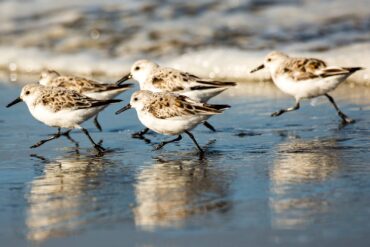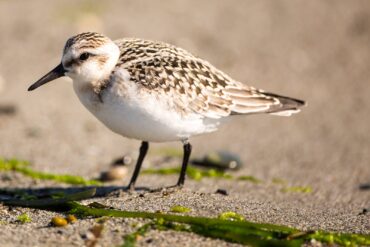
Shorebirds are a family of birds that live up to their name. They inhabit the shore. Some live on rocky shores, while others prefer sandy beaches.
A late-fall trip to virtually any Western Washington beach provides an excellent opportunity for finding a variety of wintering shorebirds, most of which breed in the Arctic. In West Sound, the most commonly seen shorebirds at this time of year include the black-bellied plover, killdeer, black turnstone, sanderling, dunlin, spotted sandpiper and greater yellowlegs. Sometimes these species join together in mixed flocks. You can also see them individually, in small clusters or in large wintering groups.
One of the more endearing shorebird species is the sanderling. A small member of the sandpiper family, the sanderling is known to chase waves, making it highly entertaining to watch. Often in large flocks of hundreds or thousands along sandy ocean beaches, sanderlings scurry along the shore in the path of a receding wave as they forage for tiny crustaceans deposited by the incoming water. As the next wave crashes in, the fast-moving sanderlings run away from the ocean, only to run back toward it when the wave recedes.

On inland shores, the wave-chasing is less frenzied, but sanderlings seem to always be in a hurry. They run quickly along the water’s edge, while picking insects off the beach or probing for invertebrates in the sand.
The sanderling lacks a hind toe, which enables it to run faster than other sandpipers. When a peregrine falcon or other avian predator threatens, a flock forms a tight ball and flies erratically over the water to escape.
The sanderling’s plumage is considerably different between seasons. During the breeding months, its head, chest, wings and upperparts are orange-brown. In the nonbreeding months, its wings and upperparts turn gray, while its chest and face match its white underparts. A black bill and legs contrast nicely against the light-colored winter plumage.
A common species across the globe, sanderlings can be found on every continent except Antarctica. In West Sound, you can observe them most frequently on the beaches of Puget Sound and the northern tip of the Kitsap Peninsula from midsummer to late spring, usually in small flocks.
Sanderlings prefer to winter on sandy beaches, but are occasionally found on gravelly shores and mudflats, where they sometimes forage alongside larger black-bellied plovers and smaller western and least sandpipers. Nonbreeding sanderlings may spend the summer months along the Washington coast, but are absent from West Sound for most of the summer.
Sanderlings breed farther north than any other Washington shorebird, traveling to the far reaches of the Arctic tundra. Their circumpolar breeding range encompasses the islands of the Canadian Arctic, the Siberian Arctic and Greenland. Sanderlings wintering in North America only have to make a 2,000-mile migration, while others travel more than 6,000 miles from their breeding grounds in the Arctic Circle to wintering grounds in southern South America.
Shorebirds are known for their incredible endurance, as many species make journeys covering thousands of miles in a nonstop flight. Sanderlings are among these high-mileage flyers and are capable of flying 2,500 miles without stopping to refuel. Before departing on their trans-global journeys, long-distance migrants can double their weight, storing fat for energy and increasing the mass of their flight muscles.
Stopovers for resting and refueling are critical for the birds to continue on their expedition. Mudflats and tidal estuaries, such as the Grays Harbor National Wildlife Refuge, are essential to migrating shorebirds. Without them, the journey would be impossible. Imagine taking a cross-country road trip and finding no gas stations along the way. Unfortunately, in many parts of the world, these critical habitats are often developed for human use, which can have devastating effects on migrating flocks.
Although sanderlings are still considered common, like many shorebirds, populations have diminished drastically over the past few decades. Some studies show that sanderlings may have declined by as much as 80 percent in the past 50 years. This is primarily due to habitat loss along migratory flight paths. Coastal pollution is another contributing factor.
Sanderlings nest on the ground, near a freshwater source, in solitary pairs or loose colonies. A female lays a clutch of four eggs, then sometimes lays a second clutch.
She and the male incubate the two sets of eggs. The young hatch after 24-31 days. Because of the lengthy incubation period, they’re capable of walking around and feeding themselves within a day of hatching. Parents stay with the fledglings for about 15 days, until the youngsters are ready to fly and fend for themselves.
Sanderlings are really fun to watch. Hardly taking a moment to rest, these speedy little birds have places to go. An unassuming little sandpiper, the sanderling sees parts of the planet that most humans will never reach.
























Comments